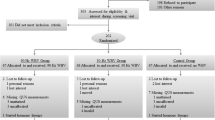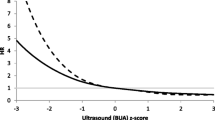Abstract
Calcaneal ultrasound has been increasingly studied for its potential in the assessment of osteoporotic fracture risk. The accuracy of such an assessment is, in part, dependent on the reproducibility of the measurement. This study examines the impact of handedness on ultrasound measurements [broadband ultrasound attenuation (BUA) and velocity of sound (VOS)] in the calcaneus. Two hundred and sixty-four subjects (57 men and 297 women) aged 51.1+13.6 years (mean ± SD) were studied. For each subject, calcaneal ultrasound measurements were performed on both heels with a McCue CUBA ultrasound densitometer. Right-handed dominance (94.7%) was determined by structured interview. In men, BUA measurements were significantly higher on the dominant side: mean difference 4.1±1.5 dB/MHz (mean ± SD;p=0.009), equivalent to 4.2+1.5% and more than 4 times the average rate of annual change in BUA. The difference between sides was greater in young (<50 years) than old men (>50 years). Among the women, the difference was not statistically significant (0.7±0.9 dB/MHz;p=0.4); however, it was significant in younger women (20–30 years) (99±4 vs 90±4 dB/MHz,p=0.01). By contrast VOS did not differ between sides in either men or women irrespective of age. Within-subject standard deviation of BUA was 9.8 dB/MHz for men and 8.6 dB/ MHz for women and the component due to right and left difference was 8.4 dB/MHz for men and 6.9 dB/MHz for women. This variability of BUA between right and left heels could increase the false-positive rate by up to 28% for a cut-off of 2 SD below the mean. These data indicate that variation between left and right heel measurements of BUA is higher than that of random error measurements, particularly in men and younger, presumably more physically active subjects. Although VOS measurements were not side dependent, in the smaller number of studies examining VOS and fracture risk, VOS appears to have a weaker predictive power than BUA. Clinical and epidemiological studies involving calcaneal BUA measurements should standardize the side measured to either the dominant or non-dominant heel, to reduce within-subject variation and increase their power.
Similar content being viewed by others
References
Porter RW, Miller CG, Grainger D, et al. Prediction of hip fracture in elderly women: a prospective study. BMJ 1990;301:638–41.
Hans D, Schott AM, Chapuy MC, et al. Ultrasound measurements on the os calcis in a prospective multicenter study. Calcif Tissue Int 1994;55:94–9.
Hans D, Dargent-Molina P, Schott AM, et al. Ultrasonographic heel measurements to predict hip fracture in elderly women: the EPIDOS prospective study. Lancet 1996;348:511–4.
Nguyen T, Sambrook P, Kelly P, et al. Prediction of osteoporotic fractures by postural instability and bone density. BMJ 1993;307:1111–5.
Massie A, Reid DM, Porter RW, screening for osteoporosis: comparison between dual energy X-ray absorptiometry and broadband ultrasound attenuation in 1000 perimenopausal women. Osteoporosis Int 1993;3:107–10.
Agren M, Karellas A, Leahey D, et al. Ultrasound attenuation of the calcaneus: a sensitive and specific discriminator of osteopenia in postmenopausal women. Calcif Tissue Int 1991;48:240–4.
Reid D, Massie A, Porter R. Bone mineral density and structure: comparison of hip and spine dual energy X-ray absorptiometry with broadband ultrasound attenuation for osteoporosis screening [abstract]. Osteoporosis Int 1991;1:194.
Naylor K, Langton C, Smith T, et al. Broadband ultrasound attenuation of the calcaneus: relationship to bone mineral density measured by dual energy X-ray absorptiometry at several sites. J Bone Miner Res 1991;6 (Suppl):350.
Baran DT, McCarthy CK, Leahey D, et al. Broadband ultrasound attenuation of the calcaneus predicts lumbar and femoral neck density in Caucasian women: a preliminary study. Osteoporosis Int 1991;1:110–3.
Mazess R, Hanson J, Bonnick S. Ultrasound measurement of the os calcis. Bone 1992;13:280.
Schott AM, Hans D, Sornay-Rendu E, et al. Ultrasound measurements on os calcis: precision and age-related changes in a normal female population. Osteoporosis Int 1993;3:249–54.
Pocock N, Noakes K, Freund J, et al. Screening for osteoporosis: the role of ultrasound measurements of the heel. Med J Aust 1996;164:367–70.
Stewart A, Reid DM, Porter RW. Broadband ultrasound attenuation and dual energy X-ray absorptiometry in patients with hip fractures. Which technique discriminates fracture risk? Calcif Tissue Int 1994;54:466–9.
Stegman MR, Heaney RP, Recker RR, et al. Velocity of ultrasound and its association with fracture history in a rural population. Am J Epidemiol 1994;139:1027–34.
Schott Am, Weill-Engerer S, Hans D, et al. Ultrasound discriminates patients with hip fracture equally well as dual energy X-ray absorptiometry and independently of bone mineral density. J Bone Miner Res 1995;10:243–9.
Hoshino H, Kushida K, Yamazaki K, et al. Effect of physical activity as caddie on ultrasound measurements of the os calcis: a cross-sectional comparison. J Bone Miner Res 1996;11:412–8.
Laugier P, Giat P, Berger G. Broadband ultrasonic attenuation imaging: a new imaging technique of the os calcis. Calcif Tissue Int 1994;54:83–6.
McCloskey EV, Murray SA, Miller C, et al. Broadband ultrasound attenuation in the os calcis: relationship to bone mineral at other skeletal sites. Clin Sci 1990;78:227–33.
Kotzki PO, Buyck D, Hans D, et al. Influence of fat on ultrasound measurements of the os calcis. Calcif Tissue Int 1994;54:91–5.
Van Daele P, Burger H, Algra D, et al. Age-associated changes in ultrasound measurements of the calcaneus in men and women: the Rotterdam Study. J Bone Miner Res 1994;9:1751–7.
Bauer DC, Gluer CC, Genant HK, et al. Quantitative ultrasound and vertebral fracture in postmenopausal women. Fracture Intervention Trial Research Group. J Bone Miner Res 1995;10:353–8.
Bouxsein ML, Courtney AC, Hayes WC. Ultrasound and densitometry of the calcaneus correlate with the failure loads of cadaveric femurs. Calcif Tissue Int 1995;56:99–103.
Didia BC, Nyenwe EA. Foot breadth in children: its relationship to limb dominance and age. Foot Ankle 1988;8:198–202.
SAS Institute. User's guide, release 6.03. Carey, NC: SAS Institute, 1988:967–80.
Coren S. Measurement of handedness via self-report: the relationship between brief and extended inventories. Percept Mot Skills 1993;76:1035–42.
Turner C, Peacock M, Timmerman L, et al. Calcaneal ultrasonic measurements discriminate hip fracture independently of bone mass. Osteoporosis Int 1995;5:130–5.
Armstrong B, Whittemore A, Howe G. Analysis of case-control data with covariate measurement error: application to diet and colon cancer. Stat Med 1989;8:1151–63.
Author information
Authors and Affiliations
Rights and permissions
About this article
Cite this article
Howard, G.M., Nguyen, T.V., Pocock, N.A. et al. Influence of handedness on calcaneal ultrasound: Implications for assessment of osteoporosis and study design. Osteoporosis Int 7, 190–194 (1997). https://doi.org/10.1007/BF01622287
Received:
Accepted:
Issue Date:
DOI: https://doi.org/10.1007/BF01622287




